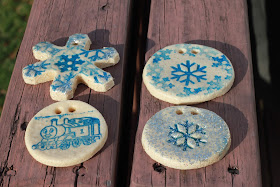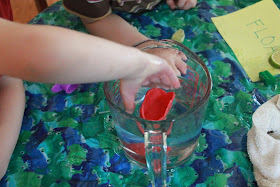This is another craft that isn't my own, but I was so thrilled with the results I had to share. My kids were excited to see the end product but the cons are that a) there is a lot of waiting involved, and b) little ones might not be able to achieve the shape they want. The simple snowflakes were manageable for my 5.5 year old, but the more complex shapes were not. It is also worth noting that the size is limited by the size of your jar, so even if your child does manage to bend the pipe cleaners into the perfect shape, it might not fit in the jar!
What you need:
- wide-mouthed glass jars (I first tried in plastic and the results were poor, though you may have better luck.)
- chenille stems (aka pipe cleaners)
- borax
- wire or ornament hooks
- boiling hot water
- skewers or pencils
There are already some great images and instructions
here. I used ornament hooks and just laid a skewer across the top of the jar. I think this is a bit easier than using wire and craft sticks. You can use white chenille stems or choose another color. The color will be muted after the crystals grow, though you can try to enhance it with food dye. You can reuse the solution for a new ornament, though I added a little more borax for each new batch. When you are all done making your ornaments, reheat the water to help remove any excess crystals in the jar.
Tip: If you are doing this with kids, do them before bedtime. When they wake up, the ornaments will be ready!
Here are some suggestions for shapes (stars and hearts would also be nice!):
 |
| Snowman. |
 |
| Snowflake. |
 |
| An angel a friend of mine made for her daughter. So cute! |
 |
| Swirl shape. |
























































